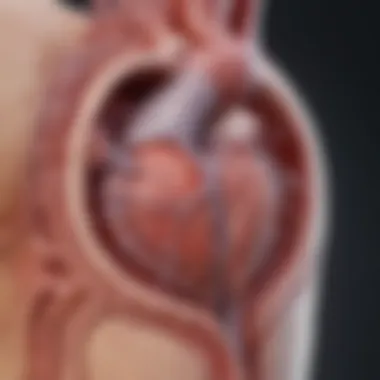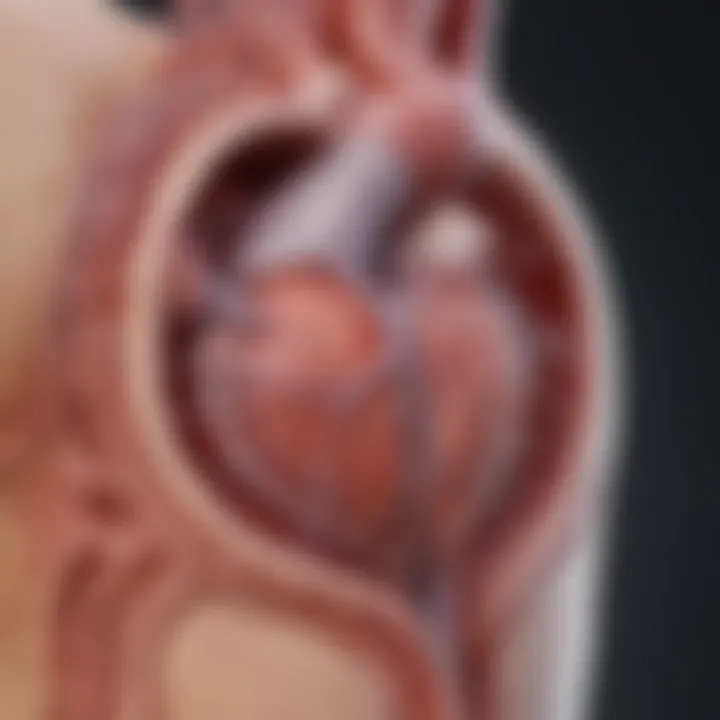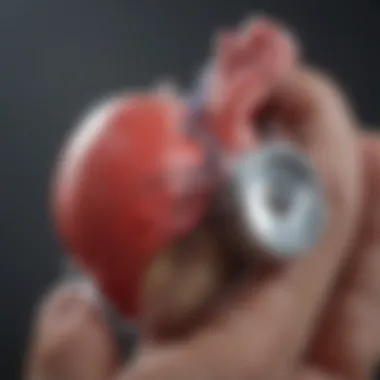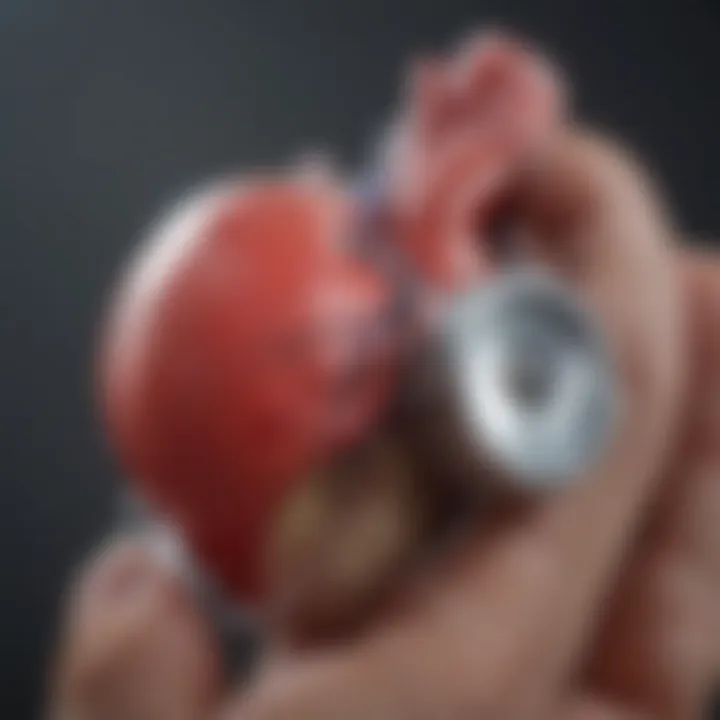Understanding Missing Heart Valves: Diagnosis & Management


Intro
Missing heart valves, a condition that can significantly alter cardiovascular functionality, demands a thorough exploration. This issue impacts not just anatomical structures but also affects overall heart health and function. The absence of one or more heart valves may result from congenital defects or acquired conditions. Understanding the intricacies surrounding this topic is critical for students, researchers, educators, and healthcare professionals who deal with cardiovascular diseases.
In this article, we will examine the implications of missing heart valves, delve into diagnosis practices, and assess management strategies. By articulating various aspects of the condition, we aim to provide a comprehensive guide that enhances knowledge and stimulates awareness among informed audiences.
Preamble to Missing Heart Valves
The topic of missing heart valves is significant in the context of cardiovascular health. It touches on both serious medical implications and the complexities of diagnosis and treatment. Understanding missing heart valves is essential not only for healthcare professionals but also for patients affected by this condition. Education around this issue can aid in early diagnosis and management, leading to better outcomes.
Definition of Heart Valves
Heart valves are structures within the heart that regulate blood flow through the chambers. There are four main types of valves: aortic, mitral, pulmonary, and tricuspid valves. Each of these valves plays a crucial role in ensuring that blood flows efficiently in one direction, preventing backflow.
A missing valve can severely disrupt this process, leading to various complications. The absence can be congenital, resulting from developmental anomalies, or acquired through disease processes. Understanding these definitions lays the groundwork for more advanced topics such as the types of missing valves and their clinical significance.
Overview of the Cardiovascular System
The cardiovascular system, composed of the heart, blood vessels, and blood, is vital for sustaining life. It is responsible for delivering oxygen and nutrients to tissues while removing waste products. The heart itself is a muscular organ that pumps blood throughout the body. Within this system, the function of heart valves is particularly critical. Any abnormalities, including missing valves, can lead to compromised circulation, impacting overall health.
In essence, a well-functioning cardiovascular system relies on each component, including heart valves, working harmoniously together. This overview highlights the interconnectedness of the system, which is necessary to understand the implications of missing heart valves.
"The cardiovascular system is not merely a circulatory network; it is a complex integration of various functions that sustain life."
Exploring missing heart valves within this context reveals their far-reaching effects, emphasizing the need for a detailed investigation into their types, causes, diagnosis, and management.
Types of Missing Heart Valves
Understanding the various types of missing heart valves is crucial for comprehending the overall implications of this condition. Each valve plays a specific role in maintaining proper blood circulation through the heart and the rest of the body. The absence of any of these valves can lead to significant physiological disruption. By dissecting the specific types of valve absence, healthcare professionals and researchers can better assess risk factors, devise management strategies, and tailor treatments for patients affected by this condition.
Aortic Valve Absence
The aortic valve is located between the left ventricle and the aorta. Its primary function is to prevent blood from returning to the heart after it has been pumped out. The absence of the aortic valve, often referred to as aortic valve agenesis, can lead to severe consequences. Blood flows back into the ventricle, which causes increased workload on the heart. Patients may exhibit symptoms such as fatigue, shortness of breath, and even heart failure if the condition is severe.
Management of this condition often requires surgical intervention. Valve replacement through either mechanical or biological prosthesis can restore proper flow dynamics. Early diagnosis through imaging and careful monitoring can also play a critical role in improving patient outcomes.
Mitral Valve Absence
The mitral valve separates the left atrium from the left ventricle. Its absence can significantly impair the heart's ability to fill efficiently and maintain effective circulation. Without a mitral valve, blood can regurgitate into the atrium during ventricular contraction. This can compromise cardiac output and lead to congestive heart failure.
Clinical management of mitral valve absence may involve a combination of surgical and medical strategies. Valve repair or replacement options can be explored based on the specific anatomical considerations of the patient. Given its central role in heart function, timely diagnosis and treatment are essential to mitigate complications.
Pulmonary and Tricuspid Valves
Both the pulmonary and tricuspid valves play essential roles in blood flow within the heart. The pulmonary valve controls blood flow from the right ventricle into the pulmonary artery, while the tricuspid valve allows blood from the right atrium to enter the right ventricle. The absence of either can severely affect pulmonary circulation and overall heart function.
In cases of pulmonary valve absence, there are significant risks for cyanosis and reduced oxygenation of the blood. Surgical interventions may include creating a conduit for blood flow or utilizing a prosthetic valve. For tricuspid valve absence, the management focus will often involve addressing the resultant hemodynamic instability and may require complex surgical solutions.
Eradicating these absences or compensating effectively is vital in maintaining a patient’s health and quality of life. Overall, understanding the types of missing heart valves paves the way for more profound insights into their management and implications.
Causes of Missing Heart Valves
Understanding the causes of missing heart valves is vital in the field of cardiology. It lays the groundwork for effectively diagnosing and managing this complex condition. By analyzing the various factors contributing to missing heart valves, healthcare professionals can develop targeted treatment strategies and enhance patient outcomes. There are two primary categories of causes: congenital factors and acquired factors.
Congenital Factors
Congenital factors refer to conditions that are present from birth. These can stem from genetic mutations or environmental influences during pregnancy. Such factors are significant because they often dictate the nature and severity of the heart valve absence. For instance, congenital heart defects, such as hypoplastic left heart syndrome, can lead to the absence of the mitral or aortic valves.
Congenital absence of heart valves may result in the following:
- Altered blood circulation patterns
- Increased workload on unaffected heart chambers
- Potential for heart failure in early life
The implications of congenital factors are profound. They not only impact immediate physical health but also have long-term effects on an individual’s cardiovascular function. Understanding these factors allows for early interventions, which can improve overall prognosis for affected individuals.


Acquired Factors
Acquired factors, as opposed to congenital ones, develop later in life due to various conditions and behaviors. These may include:
- Rheumatic fever: A complication of untreated streptococcal infections that can damage heart valves over time.
- Infective endocarditis: An infection of the heart lining, leading to valve damage or destruction.
- Degenerative diseases: Conditions like myxomatous degeneration that can weaken valve structures.
The acquired absence of heart valves has critical implications as well. It often arises from lifestyle choices, such as poor diet and lack of exercise, increasing risk factors for cardiovascular diseases. Awareness of these factors is crucial for prevention and management.
Implications of Missing Heart Valves
The implications of missing heart valves carry significant weight in both clinical practice and individual patient experiences. Understanding these implications is critical for healthcare professionals, patients, and researchers alike. Diagnosing missing heart valves not only has immediate health consequences but also long-term effects related to management strategies and lifestyle changes. Consideration of these factors plays an essential role in optimizing patient outcomes and facilitating informed decision-making.
Impact on Blood Circulation
Missing heart valves can drastically affect the functionality of the circulatory system, leading to altered hemodynamics. This can result in inadequate blood flow to vital organs, increasing the risk of severe complications such as heart failure or arrhythmias. The level of impact largely depends on which specific valve is absent, as each contributes uniquely to maintaining cardiovascular efficiency.
- Aortic valve absence can lead to a significant drop in systemic blood pressure, which in turn can strain the heart muscle.
- Mitral valve absence affects blood flow between the left atrium and ventricle. This can cause backflow, or regurgitation, leading to pulmonary congestion.
- Absence of pulmonary and tricuspid valves might have varying effects, often seen in congenital cases where other compensatory mechanisms may develop.
Overall, the cascading effects on circulation subsequently influence other organs, driving the consideration for prompt diagnosis and targeted management.
Symptoms and Clinical Manifestations
Patients with missing heart valves often present with a range of symptoms that can vary in severity. This variability often complicates diagnosis and may lead to delays in treatment. Common clinical manifestations associated with this condition include:
- Fatigue: Many individuals report unusual tiredness, stemming from ineffective blood circulation.
- Shortness of breath: This occurs during exercise or even at rest, depending on the severity of the valvular absence.
- Swelling: Edema in the lower extremities or abdomen can develop due to fluid retention.
- Irregular heartbeats: Arrhythmias are common, which can cause palpitations and further complicate the clinical picture.
It is vital that symptoms are recognized and appropriately assessed. Only through a thorough understanding of these manifestations can clinicians devise effective management strategies tailored to each patient.
Diagnosis of Missing Heart Valves
Diagnosing missing heart valves is a critical aspect of understanding how this condition affects cardiovascular health. A timely and accurate diagnosis can significantly impact treatment decisions and patient outcomes. Failure to identify absent valves may lead to mismanagement of symptoms and complications that arise due to improper blood flow. This section discusses physical examination techniques, imaging modalities, and diagnostic tests that can help confirm the presence or absence of heart valves.
Physical Examination Techniques
Physical examination techniques are fundamental tools in diagnosing missing heart valves. Health professionals often start with a thorough patient history, focusing on symptoms like shortness of breath, chest pain, and fatigue. During the physical exam, physicians may utilize palpation and auscultation. Listening for abnormal heart sounds, such as murmurs, is crucial. These murmurs may indicate turbulent blood flow due to valve abnormalities or their absence. By using these simple yet effective methods, practitioners can gather valuable preliminary information that guides further testing.
Imaging Modalities
Imaging modalities are essential for visualizing the heart's structure and function. Several techniques are included in this section:
Echocardiography
Echocardiography plays a significant role in assessing missing heart valves. This non-invasive imaging technique uses sound waves to create real-time images of the heart. A key characteristic of echocardiography is its ability to evaluate the heart's chambers and valves in detail without the need for radiation.
A unique feature of echocardiography is its Doppler capability, which measures blood flow velocity and direction. This allows healthcare providers to assess the severity of any insufficiencies or restrictiveness, thus understanding the functional implications of missing valves. However, echocardiography does have limitations, such as challenges in visualizing certain structures in patients with obesity or lung disease. Despite these drawbacks, it remains a beneficial choice for initial evaluation of valve health.
Cardiac MRI
Cardiac MRI is another advanced imaging technique that offers highly detailed images of the heart's anatomy. One notable aspect of cardiac MRI is its excellent soft tissue contrast, which is critical for detecting structural abnormalities associated with absent valves. This imaging method is also non-invasive and does not involve ionizing radiation.
The unique feature of cardiac MRI lies in its ability to assess myocardial function and perfusion. It can provide precise information regarding the heart's mechanics, which is essential for comprehensive diagnosis. The main disadvantage is that cardiac MRI can be time-consuming and requires specialized equipment and expertise. Nonetheless, its accuracy makes it a popular choice for complex cases.
CT Scans
CT scans are useful for imaging cardiac structures as well. They provide cross-sectional views of the heart and can reveal details about the presence or absence of valves. The key characteristic of CT scans is their speed; they can produce images quickly, which is advantageous in emergency settings.
One unique feature of CT scans is their capability to visualize calcifications and assess coronary arteries, which can provide context about the overall cardiovascular health of the patient. However, the use of ionizing radiation poses risks, making it less favorable for routine diagnostic purposes. Still, CT scans are valuable in specific circumstances where other modalities may not yield clear results.
Diagnostic Tests and Biomarkers
Diagnostic tests and biomarkers complement imaging techniques in the diagnosis of missing heart valves. Blood tests can measure levels of certain substances, like B-type Natriuretic Peptide (BNP), to indicate heart strain. Elevated levels can suggest heart valve disease, including potential absences. Additionally, genetic testing may be considered in cases of congenital heart defects to identify underlying causes.
Overall, these diagnostic approaches are vital for forming a complete clinical picture and guiding appropriate management strategies. Understanding missing heart valves involves integrating findings from physical examinations, imaging studies, and laboratory tests for an accurate diagnosis.


Management of Missing Heart Valves
The management of missing heart valves is crucial in maintaining cardiovascular health. Absent or malfunctioning heart valves can severely impact the efficiency of blood circulation, leading to a variety of health issues. Effective management strategies can alleviate symptoms, improve quality of life, and reduce the risk of more serious complications. This section covers both surgical and medical management approaches, offering insights into treatment options available for individuals with this condition.
Surgical Interventions
Surgical interventions are often the primary approach for addressing the absence of heart valves. These techniques can restore proper heart function and enhance patient outcomes significantly.
Valve Repair Techniques
Valve repair techniques focus on correcting the existing structures of the heart valves, rather than replacing them entirely. This approach is advantageous as it often preserves the patient's own tissue, which can lead to improved functionality and reduced risk of complications. Key characteristics of valve repair include its ability to restore normal valve anatomy and function.
Benefits of Valve Repair:
- Minimally Invasive: Repairing valves can sometimes be performed through smaller incisions, leading to quicker recovery.
- Sparing Natural Tissue: Keeping the patient’s own tissue minimizes the risk of rejection or complications associated with artificial materials.
Considerations:
- Not all valves are amenable to repair. The decision is based on the valve's condition and the specific anatomical issues involved.
- Long-term outcomes can vary, and close monitoring is essential.
Valve Replacement Options
When valve repair is not feasible, valve replacement is the next best solution. This option includes substituting the missing valve with either a mechanical or biological valve.
Mechanical valves are durable and designed for long-term use, while biological valves (such as those made from animal tissue) often require less blood thinning medication post-surgery.
Key Characteristics of Valve Replacement:
- Variety of Options: Surgeons can choose between mechanical and biological valves, catering to individual patient needs.
- Enhanced Flow Dynamics: Replacement valves can provide better flow characteristics, improving overall heart function.
Advantages and Disadvantages:
- Mechanical Valves:
- Biological Valves:
- Advantages: Long lifespan and strength.
- Disadvantages: Higher risk of blood clots, necessitating lifelong anticoagulation therapy.
- Advantages: Lower risk for clotting issues.
- Disadvantages: Limited durability, requiring potential replacement after some years.
Medical Management
Medical management includes pharmacological and non-pharmacological strategies to manage symptoms associated with missing heart valves. These strategies aim to maintain optimal cardiovascular function and support the patient’s overall health.
Medications for Symptom Relief
Medications play an important role in alleviating the symptoms caused by missing heart valves. Common medications include diuretics, beta-blockers, and ACE inhibitors. Diuretics can reduce fluid retention, while beta-blockers help in managing heart rate. ACE inhibitors serve to lower blood pressure and decrease the workload on the heart.
Key Characteristics of Medications:
- Symptomatic Relief: They effectively address symptoms like shortness of breath and fatigue.
- Chronic Management: Medications can help stabilize patients who are not candidates for surgery.
Advantages and Disadvantages:
- Advantages: Medications can improve quality of life and prolong survival rates.
- Disadvantages: Possible side effects and the need for ongoing adjustments in prescriptions.
Long-term Monitoring Strategies
Long-term monitoring is essential for patients living with missing heart valves. Regular check-ups and tests help in assessing heart function and detecting potential complications early.
Key Features of Monitoring:
- Comprehensive Assessments: Using echocardiograms and cardiac MRIs can offer detailed insights into the heart's condition.
- Tailored Care Plans: Individualized monitoring strategies can be developed based on each patient's needs.


Advantages and Disadvantages:
- Advantages: Early detection of issues can prompt timely interventions, improving outcomes.
- Disadvantages: Regular medical visits and tests can be burdensome for patients, both logistically and financially.
Overall, the management of missing heart valves requires a multifaceted approach that considers both surgical and medical options. Each method presents unique benefits and challenges, and personalizing the treatment to the individual patient is essential.
Living with Missing Heart Valves
Life with missing heart valves is a consideration that demands attention. Understanding the nuances of these living conditions is crucial for patients who are affected by this condition. It impacts daily routines, physical health, emotional well-being, and social interactions. As the cardiovascular system adapts to the absence of proper valve function, individuals may experience various symptoms. By focusing on lifestyle adjustments and psychosocial support, individuals can better manage their conditions.
Lifestyle Adjustments
Adapting to living with missing heart valves requires significant lifestyle modifications. These adjustments can help improve overall quality of life. Other than medical management, patients should focus on the following areas:
- Diet: Consuming a heart-healthy diet is essential. This includes minimizing salt intake and focusing on lean proteins, fruits, and vegetables.
- Exercise: Engage in regular, moderate physical activity appropriate for the individual's condition. Activities such as walking or swimming can promote cardiovascular health while being mindful not to overexert oneself.
- Regular Monitoring: Regularly check blood pressure and keep track of symptoms associated with the condition. This practice can help in early detection of problems.
- Medication Adherence: Always follow the prescribed medication regimen. It is key in managing symptoms effectively.
Making these changes can lead to better health outcomes, allowing individuals to live more comfortably and maintain a sense of normalcy in their lives.
Psychosocial Support
Psychosocial support plays a significant role in managing the stress and anxiety surrounding missing heart valves. The emotional well-being of an individual often dictates their overall health condition. It is important to foster a support system, which may include:
- Family and Friends: Encouragement from loved ones can help patients navigate emotional challenges. Open communication is critical.
- Support Groups: Joining support groups for people with similar conditions can provide comfort and practical advice. Sharing experiences can alleviate feelings of isolation.
- Mental Health Professionals: Consulting with a psychologist or counselor can prove beneficial. These professionals can offer coping strategies and emotional tools.
- Educational Resources: Learning more about heart health can empower individuals. Knowledge can lead to more informed choices and reduce fears about the unknown.
"Psychosocial support isn't just an addition to treatment. It is an essential part of the healing process."
Combining lifestyle adjustments with psychosocial support creates a robust framework for living well despite the challenges of missing heart valves. This holistic approach is vital for nurturing both the body and the mind.
Current Research Trends
Current research trends in cardiology offer significant insights into the nuances of missing heart valves. Research in this area aims to develop better diagnostic tools, refine surgical techniques, and explore new medical therapies. Understanding these trends can aid healthcare professionals and researchers in making informed decisions regarding treatment options for patients with absent heart valves.
Innovations in Cardiac Surgery
Surgical techniques for addressing missing heart valves have evolved greatly in recent years. Innovations in cardiac surgery include minimally invasive approaches, which minimize trauma and recovery time for patients. For instance, robotic-assisted surgery allows for precision that is often not possible with traditional methods. These techniques are not just about improving recovery but also enhancing surgical outcomes in complex cases.
Some notable techniques that are gaining traction include:
- Transcatheter Aortic Valve Replacement (TAVR): Initially developed for older patients, TAVR is now considered for younger patients with appropriate anatomical criteria. This method uses a catheter to insert a new valve without open-heart surgery.
- Mitral Valve Clip: This procedure is for patients with mitral valve regurgitation who are high-risk for surgery. The clip provides a less invasive option while preserving heart function.
Such innovations are paving the way for more patients to receive effective treatment with reduced procedural risks. Moreover, ongoing clinical trials continue to explore new techniques for valve reconstruction that may yield further advancements.
Emerging Therapeutic Approaches
The landscape of medical management for missing heart valves is also changing. There is a growing interest in pharmacological therapies that can improve patient outcomes. Current research is focused on understanding the role of medications in managing symptoms and enhancing quality of life.
Some emerging therapeutic approaches include:
- Antithrombotic Treatment: Patients often face increased risk of thrombosis post-surgery. Research into optimized antithrombotic regimens aims to balance efficacy against bleeding risks in this population.
- Regenerative Medicine: Advances in tissue engineering may allow for the development of bioengineered heart valves. Such an approach would minimize rejection and improve longevity of the implanted prosthetics.
- Biomarker Studies: Research is also investigating specific biomarkers that may predict outcomes, facilitate diagnosis, and identify patients who will benefit most from various interventions.
The integration of innovative surgical techniques and new pharmacological treatments represents a significant shift in how missing heart valves are managed within the healthcare system. This evolving landscape not only aims at enhancing survival rates but also focuses on improving the overall well-being of patients.
These current research trends underscore the importance of continuous education and adaptation among healthcare professionals. Staying abreast of these developments can greatly impact clinical practices and improve patient care.
Culmination
The conclusion serves as a vital element in this article by summarizing the complexities surrounding missing heart valves. Addressing such a significant health issue enhances understanding and awareness among various stakeholders, including students, researchers, and healthcare professionals. This article has addressed the definitions, types, causes, implications, and management of missing heart valves. Through this comprehensive approach, the information presented connects the clinical aspects to real-life implications experienced by patients.
Recap of Key Points
- Definition of Heart Valves: Heart valves are crucial for maintaining proper blood flow. Their absence can disrupt circulation profoundly.
- Types of Missing Heart Valves: Recognizing the types, such as aortic and mitral valve absence, is essential for targeted diagnosis and treatment.
- Causes: Both congenital and acquired factors can lead to the absence of heart valves, affecting different demographics in various ways.
- Diagnosis Procedures: Utilizing methods like echocardiography and cardiac MRI is crucial for identifying the presence or absence of heart valves.
- Management Strategies: Surgical interventions, alongside medical management, provide avenues for treatment and symptom relief.
- Lifestyle Adjustments: Recommendations for lifestyle changes underscore the condition's impact on daily life for those affected.
- Current Research Trends: Innovations are emerging in cardiac surgery, coupled with new therapeutic approaches that promise to enhance patient care.
Future Directions in Research
Research on missing heart valves is evolving. Focused studies are increasingly important to explore multiple avenues. The future may involve:
- Gene Therapy: Investigating how genetic factors affect the development and repair of heart valves could change the therapeutic landscape.
- Regenerative Medicine: Promising techniques aim toward creating bioengineered valves for replacement or repair, potentially shifting management practices.
- Longitudinal Studies: More extensive studies to track outcomes over time can provide invaluable data to inform clinical practice and patient education.
Ultimately, this field requires ongoing research efforts aimed at improving diagnostic tools, therapeutic techniques, and patient outcomes. The evolving understanding of missing heart valves calls for an interdisciplinary approach, merging clinical, laboratory, and technology-driven perspectives.







